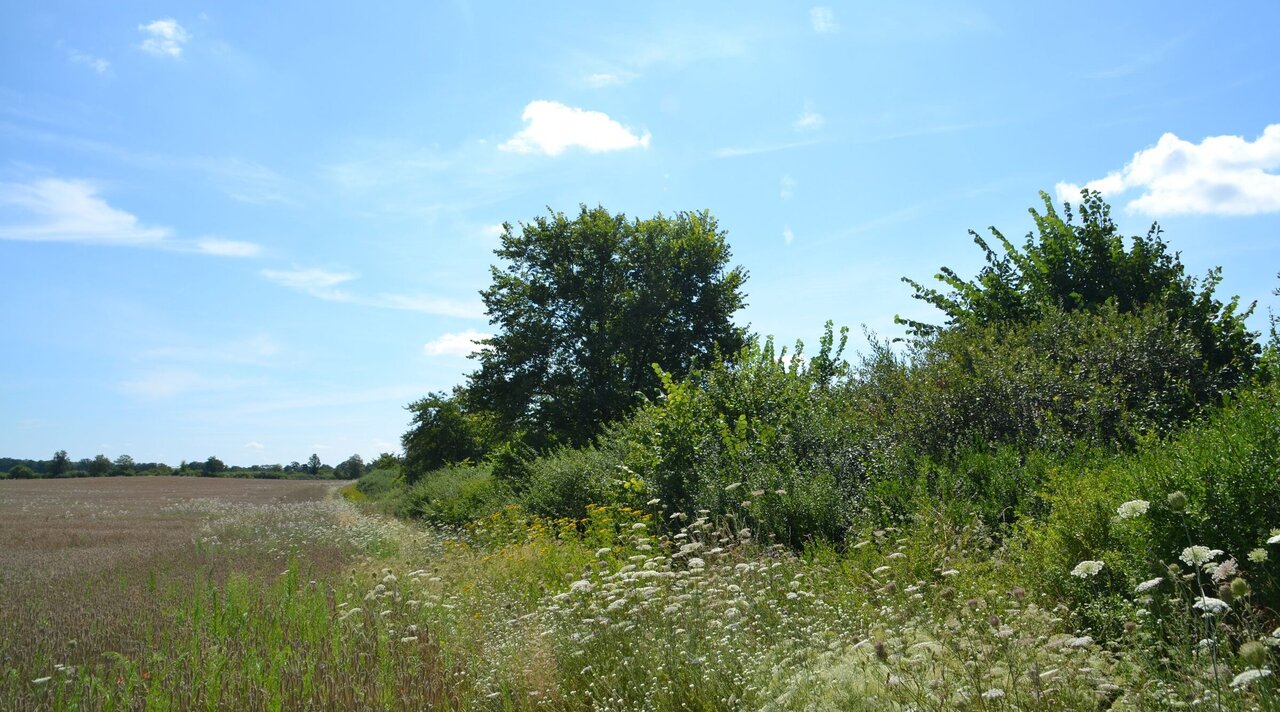Project
CatchHedge - Carbon sequestration of hedgerows and field copses

Carbon sequestration of hedgerows and field copses (CatchHedge)
Hedgerows contribute to mitigating climate change - new plantings of hedgerows on arable land have great potential to contribute to climate protection. Hedgerows store nearly as much carbon per hectare as forests.
Background and Objective
Hedges and field copses provide a variety of ecosystem services, such as soil and erosion protection, improvement of the microclimate, production of firewood and fodder, and make an important contribution to the conservation of biodiversity. So far, little attention has been paid to the potential of planting new hedgerows for climate protection. When new hedges are planted, additional CO2 is bound in the growing biomass and as soil organic carbon in the long term.
According to the Federal Climate Protection Act, the land use, land-use change and forestry (LULUCF) sector has to improve its carbon binding potential (carbon sink). The planting of hedgerows offers a promising way to improve carbon storage in agricultural landscapes. From a farm managers’ view, such new plantings, however, raise additional costs such as increased labour input for maintenance, loss of arable land or lower yields due to shading.
In the CatchHedge project, we want to comprehensively quantify and evaluate the new planting of hedgerows and field copses as a climate protection option. We take into account the possible positive or negative side effects on neighbouring agricultural land and biodiversity as well as different use options and the profitability of hedges. With an overall economic assessment, we develop an efficient design and implementation paths for a hedgerow expansion support programme.
Target Group
Politics, agricultural practice, consultants, science, interested professional public
Approach
The project is carried out by the Thünen Institutes of Climate-Smart Agriculture, Biodiversity, Farm Economics, Rural Studies and Organic Farming. To optimise hedgerow expansion as a climate protection option and enhance implementability, we carry out the following steps:
- Collect data on the local water balance of hedgerow landscapes, yield effects of adjacent agricultural crops, and species richness at 12 existing hedgerow sites.
- Modelling of the biodiversity effect of hedgerows and development of scenarios for hedgerow planting in agricultural landscapes in order to optimise the positive effects for biodiversity and habitat connectivity.
- Analyse additional options for the use of hedgerows such as foliage fodder, shelterwoods for animals, wooden crops, agrowood production and use of biochar.
- Analyse the profitability of different options for the use of hedgerows including revenues from trading CO2
- Specify target regions for the establishment of hedgerows, considering legal restrictions and synergies
- Assessment of the national implementation potential for climate protection hedgerows.
- Evaluate potential implementation options for promoting hedgerows and derive implementation costs based on the profitability analyses.
Our Research Questions
- What contribution can new hedgerows make as CO2 sinks to climate mitigation in Germany?
- What is the optimal proportion and spatial distribution of hedge areas to support the biodiversity goals?
- Which are the use and exploitation options for economic valorisation of hedgerows?
- What are the individual farm costs of the establishment and maintenance of hedgerows in different regions of Germany?
- How should the legal and institutional framework for promoting new hedgerow establishment be designed?
Thünen-Contact

Involved Thünen-Partners
- de Witte, ThomasBW Institute of Farm Economics
- Don, AxelAK Institute of Climate-Smart Agriculture
- Heukrodt, SofiaAK Institute of Climate-Smart Agriculture
- Kruse, MarionOL Institute of Organic Farming
- Landmann, MarghittaBW Institute of Farm Economics
- Lembke, HannahBD Institute of Biodiversity
- Paulsen, Hans MartenOL Institute of Organic Farming
- Plaas, ElkeBW Institute of Farm Economics
- Schmidt, FelixOL Institute of Organic Farming
- Schütze, BeritLV Institute of Rural Studies
- Thiele, JanBD Institute of Biodiversity
- Tönshoff, CharlotteLV Institute of Rural Studies
Funding Body
-
Federal Ministry of Agriculture, Food and Regional Identity (BMLEH)
(national, öffentlich)
Duration
1.2023 - 12.2025
More Information
Project status:
ongoing
Newsletter "Praxiswissen Hecken" (German)
During the course of the project, we will publish results from the project at regular intervals in our newsletter "Praxiswissen Hecken" (German). Don't want to miss an issue? Then sign up for the newsletter at catchhedge@thuenen.de
(pdf-documents, not barrier-free)
2025/02: Gehölzschutz – Erfahrungen mit eigenen Praxisbeispielen (German)
2025/01: Pflanzaktion - Wir pflanzen eine Fruchthecke (German)
2024/04b: Heizen mit Hecken-Holzhackschnitzeln – Ein Praxisbeispiel aus Schleswig-Holstein (German)
2024/04a: Hackschnitzel aus (Feld-)Hecken – Möglichkeiten und Grenzen (German)
2024/03: Die beste Hecke für die Artenvielfalt - wie sieht sie aus? (German)
2024/02: Förderung für Heckenneuanlage und -pflege: Welche Unterstützungsmöglichkeiten gibt es? (German)
2024/01: Rechtlicher Status von Hecken (German)
2023/02: Hecken in der Landwirtschaft = effiziente Kohlenstoffspeicher (German)
2023/01: CO2-Bindung durch Hecken – wieviel Klimaschutz ist möglich? (German)
Publications to the project
- 0
Kruse M, Schmidt F, Fenger F, Paulsen HM (2025) Agroforst - neue Perspektiven für den ökologischen Landbau [online]. In: Westerwalbesloh P, Minarsch E-M, Schillem S, Gernhardt A, Weckenbrock P (eds) Vielfalt pflanzen, Agroforst skalieren : 10. Forum Agroforstsysteme, 17. & 18. September in Gießen Campus und Modellflächen ; Tagungsband. Cottbus: DeFAF, p 28, zu finden in <https://agroforst-info.de/wp-content/uploads/2025/10/251020_Tagungsband_10.ForumAgroforstsysteme_Okt25-s.pdf> [zitiert am 04.12.2025]
- 1
Kruse M, Schmidt F, Paulsen HM (2025) Gehölzschutz - Erfahrungen mit eigenen Praxisbeispielen. Trenthorst: Thünen-Institut für Ökologischen Landbau, 6 p, Praxiswissen Hecken 2025/02
- 2
Schütze B, Heukrodt S, Kruse M, Landmann MY, Lembke HA, Schmidt F, Stegen R, Don A, Paulsen HM, Plaas E, Thiele J, Wegmann J (2025) Hecken als Kohlenstoffsenke und Lebensraum in der Agrarlandschaft fördern - Umsetzung erleichtern. Ber Landwirtsch 103(2), DOI:10.12767/buel.v103i2.552
- 3
Heukrodt S, Kruse M, Landmann MY, Lembke HA, Schütze B (2025) Heckenneuanlagen und ihre positiven Effekte fördern. In: RessortForschtKlima (ed) Ergebnisse aus drei Jahren Forschung für mehr Klimaschutz in Landwirtschaft, Wald und Ernährung : Abschlussbericht der RessortForschtKlima-Projekte. Göttingen: OpenAgrar, pp 23-26, DOI:10.3220/253-2025-220
- 4
Schütze B, Wegmann J (2025) Identifying priority areas for establishing new hedgerows in Germany. In: Lieskovský J, Baránková Z, Miklósová V, Hilbert H, Ponecová Z (eds) IALE 2025 European Landscape Ecology Congress : Landscape perspectives in a rapidly changing world ; Bratislava, Slovakia, September 2-5, 2025 ; Book of abstracts. Bratislava, Slovakia: Institute of Landscape Ecology, Slovak Academy of Sciences, p 233, DOI:10.31577/2025.9788089325344
- 5
Kruse M, Schmidt F, Paulsen HM (2025) Pflanzaktion - wir pflanzen eine Fruchthecke. Trenthorst: Thünen-Institut für Ökologischen Landbau, 4 p, Praxiswissen Hecken 2025/01
- 6
Schütze B, Tönshoff C, Wegmann J (2024) Analyse des rechtlichen Rahmens und von Förderprogrammen für die Neuanlage von Hecken. Braunschweig: Johann Heinrich von Thünen-Institut, 50 p, Thünen Working Paper 249, DOI:10.3220/WP1729166201000
- 7
Schütze B, Tönshoff C (2024) Förderung für Heckenneuanlage und -pflege: Welche Unterstützungsmöglichkeiten gibt es? Braunschweig: Thünen-Institut für Lebensverhältnisse in ländlichen Räumen, 4 p, Praxiswissen Hecken 2024/02
- 8
Landmann MY, Plaas E (2024) Hackschnitzel aus (Feld-)Hecken - Möglichkeiten und Grenzen [online]. Braunschweig: Thünen-Institut für Betriebswirtschaft, 7 p, Praxiswissen Hecken 2024//04a, zu finden in <https://www.thuenen.de/media/institute/lv/Projekt-Downloads-pdf/CatchHedge/2024-04a__Hackschnitzel_aus__Feld-_Hecken-Moeglichkeiten_und_Grenzen.pdf> [zitiert am 26.11.2024]
- 9
Kruse M, Schmidt F, Paulsen HM (2024) Heizen mit Hecken-Holzhackschnitzeln - Ein Praxisbeispiel aus Schleswig-Holstein. Trenthorst: Thünen-Institut für Ökologischen Landbau, 6 p, Praxiswissen Hecken 2024/04b
- 10
Schütze B, Tönshoff C, Wegmann J (2024) Hemmnisse im rechtlichen und förderpolitischen Kontext für den Ausbau von Klimaschutzhecken. In: Köchy M (ed) Agrarforschung zum Klimawandel: Konferenz der Deutschen Agrarforschungsallianz, 11.-14.03.2024, Potsdam, unter der Schirmherrschaft des Bundesministeriums für Ernährung und Landwirtschaft; Programm und Beiträge, Stand: 7. Mai 2024. Braunschweig: DAFA, p 89, DOI:10.3220/DAFA1713767287000
- 11
Schmidt F, Kruse M, Paulsen HM (2024) Kohlenstoffspeicherung in Böden und Gehölzen in einem landwirtschaftlichen Betrieb. In: Bruder V, Röder-Dreher U, Breuer L, Herzig C, Gattinger A (eds) Landwirtschaft und Ernährung - Transformation macht nur gemeinsam Sinn : 17. Wissenschaftstagung Ökologischer Landbau, 5.-8. März 2024, Justus-Liebig-Universität Gießen ; Tagungsband. 1. Auflage. Frankfurt am Main: FiBL Deutschland eV, pp 372-373, DOI:10.5281/zenodo.11204339
- 12
Schütze B, Tönshoff C, Wegmann J (2024) Neuanlage von Hecken: Hemmnisse im rechtlichen und förderpolitischen Kontext. Naturschutz Landschaftsplanung 56(11):28-35, DOI:10.1399/NuL.79851
- 13
Schütze B, Tönshoff C (2024) Rechtlicher Status von Hecken. Braunschweig: Thünen-Institut für Lebensverhältnisse in ländlichen Räumen, 4 p, Praxiswissen Hecken 2024/01
- 14
Schütze B, Plaas E, Wegmann J (2024) Sozioökonomische Analyse zum Aufbau von Klimaschutzhecken. Schr Gesellsch Wirtsch Sozialwiss Landbaues 59:365-367
- 15
Schmidt F, Kruse M, Paulsen HM (2023) Hecken in der Landwirtschaft = effiziente Kohlenstoffspeicher [online]. Trenthorst: Thünen-Institut für Ökologischen Landbau, 4 p, Praxiswissen Hecken 02/2023, zu finden in <https://www.thuenen.de/media/institute/lv/Projekt-Downloads-pdf/CatchHedge/2023_02__Hecken-in-der-Landwirtschaft_effiziente-Kohlenstoffspeicher.pdf> [zitiert am 28.11.2023]







